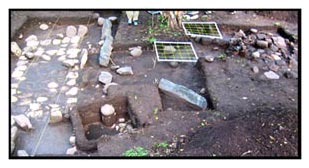| FAMSI © 2007: Patricia A. Urban |
||
Rural Production in Northwest Honduras: The 2004 Season of the Lower Cacaulapa Valley Archaeological Project
Research Year: 2004 Table of Contents
Introduction The Late Classic (A.D. 600-800), Terminal Classic (A.D. 800-1000), and Early Postclassic (A.D. 1000-1300) mark major shifts in the political economies of Southeast Mesoamerica (the adjoining portions of eastern Guatemala, western Honduras, and El Salvador; Figure 1). Late Classic magnates centralized power and engaged in long-distance exchanges with their elite peers to secure symbols of rulership. From the Terminal Classic through Early Postclassic many of the realms bound together in these interaction networks began to disintegrate while intersocietal transactions dwindled. By the early 14th century, only the ruins of grand political dreams remained throughout much of the area (Hasemann et al. 1978; Hendon 2000; Joyce 1988, 1991; Nakamura et al. 1991; Robinson 1987; Schortman 1993; Schortman et al. 1986; Urban and Schortman 1988; Sharer 1990; Sheptak 1987; Urban and Schortman 1988; Webster et al. 2000). Though this general picture is clear enough, we know little about how power contests played out on the local level and the implications of these competitions for broader scale developments. There is also the creeping suspicion that heterogeneous political, economic, and cultural forms and processes among polities are obscured within seemingly uniform regional trends. The investigations sponsored by FAMSI in 2004 within the adjoining lower Cacaulapa and middle Chamelecon drainages of northwest Honduras focused on these issues. Specifically, excavations at five rural hamlets in these narrow valleys (see Figure 2 for site locations) were designed to shed light on what roles, if any, craft production played in advancing elite domination strategies and thwarting those grand designs. Our earlier research in the nearby Naco valley suggested that Late Classic processes of political centralization were underwritten, in part, by paramount monopolies over fashioning and distributing a suite of generally needed goods. The majority of people, therefore, became clients of the monopolists, constrained to obey the latter or lose access to essential commodities (Urban et al. 1996; Schortman and Urban 1994; see also Brumfiel and Earle 1987; Ekholm 1972; Hayden 1995, 1998). Ongoing research, however, at the sizable lower Cacaulapa center of El Coyote ca. 9 km southwest of Naco indicated that the power of its Late Classic rulers was not founded on control over craft production. In fact, El Coyote's residents seemed to be consumers, not manufacturers, of basic goods. The situation seemingly changed during the Early Postclassic (A.D. 1000-1300) when Naco's Late Classic capital, La Sierra, was abandoned: craft production of all sorts in the valley ended, but El Coyote now became the center of fairly large-scale chert tool and, possibly, copper processing industries. Such contrasts strongly suggest the existence, side-by-side, of two very different political economies, each with its own distinctive trajectory. Different paths may have led to the same ends. Learning more about these processes, and why two adjacent polities had such different histories, required expanding research from ancient capitals to their rural hinterlands. It was only in this way that we could reconstruct patterns of production, consumption, and distribution for entire realms (Costin 1991; Pool 1992; Tosi 1984). This information is crucial to understanding how rural and urban populations, elites and commoners, together fashioned the evolving political and economic structures whose outlines we were beginning to perceive. Excavations conducted in 70 (15%) of Naco's 463 rural settlements were completed by 1996, but only five comparable sites, out of a total of 73 known examples (6.8%), had been investigated near Las Canoas (16 sites) and El Coyote (57 sites). The 2004 season was designed, in part, to redress this imbalance. The five locales chosen for study in 2004, Sites 120, 161, 162, 598, and 607, are in a line extending 4 km west/southwest along the Rio Chamelecon from the site of Las Canoas (Site 202) and 6.5 km south from the Rio Cacaulapa's junction with the Chamelecon to El Coyote (Figure 2). Las Canoas is a moderately large center containing 120 structures clustered around a central plaza bounded by five monumental platforms (structures at least 1.5 m high; Figure 3). Excavations conducted here in 2002 by M. Stockett suggested that Las Canoas was founded as an outlier of La Sierra early in the Late Classic. Its residents apparently mediated contacts between the Late Classic La Sierra realm and those polities lying to the west. Further, the site was a major center of ceramic production throughout the Late Classic, possibly extending into the Terminal Classic (A.D. 800-950) after the focal point of public administration and ritual, the central plaza, had fallen into disuse. Additional excavations at Las Canoas in 2004 (not funded by FAMSI) were designed to test this model. By studying five rural settlements dispersed between Las Canoas and El Coyote, we hoped to assess how patterns of production, consumption, and distribution shifted between areas that were likely part of the La Sierra political economy, Sites 607 and 598 near Las Canoas in the Chamelecon valley, and those outside its sphere, Sites 120, 161, and 162 in the lower Cacaulapa valley. As noted above, we were especially interested in political, economic, and cultural developments dating to the Late Classic through Early Postclassic but avidly collected data pertaining to other periods as well. Click to download the report in PDF format: The PDF files require Adobe Acrobat Reader.
Submitted 08/23/2006 by: |
||
| Return to top of page | ||
|
Text links to all pages at this site are available at the FAMSI INDEX |
||

